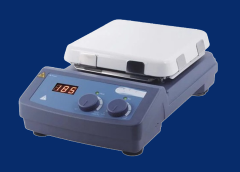- Water Testing Meters
- Anemometer
- Length & Distance Meter
- Multimeter & Clamp Meter
- Light and Sound Meter
- Slide Calipers & Screw Gauge
- Thermometer & Hygrometer
- Milk Testing Meters
- Paper, Grain & Wood Testers
- Stopwatch & Timers
- Soil Testing Meters
- Refractometers & Analyzer
- Magnetic Compass
- Tachometer & Megger
- Thickness & Dia-Meters
- Other Meter And Accessories
The Ultimate Guide to Magnetic Stirrers: Everything You Need to Know

Magnetic stirrers are a crucial piece of equipment in various industries, including chemistry, biology, and pharmaceuticals. These devices use a rotating magnetic field to create a swirling motion in liquid samples, allowing for efficient mixing and blending. Whether you are a scientist, researcher, or lab technician, understanding the fundamentals and applications of magnetic stirrers is essential for achieving accurate and reliable results. This comprehensive guide will provide you with everything you need to know about magnetic stirrers, including their operation, types, maintenance, and important safety considerations. So, let’s dive in and explore the world of magnetic stirrers together!
What is a magnetic stirrer and how does it work?
Now that we understand the importance of magnetic stirrers in various industries, let’s delve deeper into what exactly a magnetic stirrer is and how it functions.
A magnetic stirrer is a laboratory device that employs a rotating magnetic field to create a swirling motion in liquid samples. It consists of two main components: a magnetic stir bar or flea, and a magnetic stir plate.
The magnetic stir bar, typically made of a magnet encased in a heat-resistant material such as PTFE or glass, is placed inside the liquid sample. The magnetic stir plate, which contains a rotating magnet, generates a rotating magnetic field. This field interacts with the magnet inside the stir bar, causing it to spin and create a stirring motion in the liquid.
By continuously rotating the magnetic stir bar, magnetic stirrers ensure uniform mixing and blending of substances. They come in various sizes and configurations, with some models offering additional features such as heating or digital controls.
Understanding how a magnetic stirrer works is essential for optimizing its performance and achieving accurate results in your experiments. In the next section, we will explore the different types of magnetic stirrers available in the market.
Types of magnetic stirrers and their applications
Now that we have a clear understanding of what magnetic stirrers are and how they function, let’s explore the different types of magnetic stirrers available in the market and their specific applications.
1. Basic Magnetic Stirrers:
These stirrers are the most common and widely used in laboratories. They are generally compact, affordable, and offer a simple rotating magnetic field for stirring applications. Basic magnetic stirrers are ideal for routine mixing tasks, such as dissolving solids in liquids or creating homogeneous solutions.
2. Hotplate Magnetic Stirrers:
Hotplate magnetic stirrers combine the functionality of a magnetic stirrer with a heating plate. They are designed to heat and stir samples simultaneously, making them suitable for experiments requiring precise temperature control and uniform mixing. Hotplate magnetic stirrers are commonly used in chemistry, biology, and research laboratories.
3. Multichannel Magnetic Stirrers:
As the name suggests, multichannel magnetic stirrers can stir multiple samples at once. They are equipped with multiple stirring positions, allowing simultaneous stirring of different samples in separate containers. Multichannel magnetic stirrers are particularly beneficial for high-throughput laboratories or when performing multiple experiments simultaneously.
4. Digital Magnetic Stirrers:
Digital magnetic stirrers provide precise control over stirring speed and temperature. They feature digital displays and touch-sensitive controls, allowing users to set specific parameters and monitor them accurately. These stirrers are commonly used in applications where precise control and reproducibility are required, such as in pharmaceutical or biotechnology industries.
5. Reverse Magnetic Stirrers:
Reverse magnetic stirrers are specifically designed for applications where the stirring is required in a reverse direction. They are commonly used in applications such as chemical reactions or hydrolysis, where reversing the stir bar’s direction at specific intervals is necessary.
Each type of magnetic stirrer has its unique benefits and applications. By understanding the different options available, you can choose the one that best suits your laboratory needs and optimizes your experimental outcomes.
In the upcoming section, we will discuss the key factors to consider when selecting a magnetic stirrer.
Factors to consider when choosing a magnetic stirrer
When choosing a magnetic stirrer, there are several key factors to consider that will ensure you make the most suitable choice for your laboratory needs.
1. Stirring Capacity: Assess the volume of your samples and determine the stirring capacity required. Different magnetic stirrers have varying maximum stirring capacities, so it is crucial to select one that can accommodate your sample size.
2. Speed and Temperature Range: Consider the speed and temperature range required for your experiments. Ensure that the magnetic stirrer you choose can achieve the desired speeds and temperatures. Some applications may require higher speeds or specific temperature ranges, so it is essential to select a stirrer that can meet these requirements.
3. Stability and Durability: Look for a magnetic stirrer with stable construction and excellent durability. Check if the stirrer is made from robust materials that can withstand frequent use and resist corrosion. A stable and durable magnetic stirrer will ensure accurate and reliable results over an extended period.
4. Enhanced Features: Consider whether you require any additional features, such as timer functions, programmable options, or compatibility with external devices. These enhanced features can enhance efficiency and convenience in your laboratory workflow.
5. Safety Features: Ensure that the magnetic stirrer has appropriate safety features, such as overheating protection or automatic shutdown in case of any malfunctions. Safety should always be a top priority when working with any laboratory equipment.
By carefully considering these factors, you can select a magnetic stirrer that meets your laboratory requirements and enhances your experimental outcomes. In the next section, we will discuss the maintenance and care of magnetic stirrers to ensure their longevity and optimal performance.
Tips for effectively using a magnetic stirrer
Once you have chosen the perfect magnetic stirrer for your laboratory needs, it is important to understand how to use it effectively to maximize its performance. Here are some essential tips to keep in mind:
1. Proper Placement: Ensure that the magnetic stir bar is positioned correctly in the vessel. It should be placed at the center to achieve consistent and efficient stirring.
2. Sample Compatibility: Before using a magnetic stirrer, make sure that your sample is compatible with the stirring process. Certain chemicals or substances may react differently when subjected to stirring, so always check for any potential risks.
3. Start with Low Speed: To avoid splashing or spillage, start the stirring process at a low speed and gradually increase it until you reach the desired speed. This will help to minimize any disturbances and achieve a well-controlled stirring motion.
4. Avoid Overloading: Do not exceed the recommended maximum stirring capacity of the magnetic stirrer. Overloading can strain the motor and compromise the stability and performance of the stirrer.
5. Clean and Maintain Regularly: After each use, thoroughly clean the magnetic stirrer, including the stirring bar, to prevent contamination. Regular maintenance, such as lubricating the moving parts, ensures smooth operation and prolongs the life of the equipment.
By following these tips, you can optimize the performance of your magnetic stirrer and achieve accurate and reliable results in your laboratory experiments. In the next section, we will discuss troubleshooting common issues that may arise when using a magnetic stirrer.
Safety precautions when working with magnetic stirrers
While magnetic stirrers are incredibly useful tools in a laboratory setting, it is important to prioritize safety when using them. Here are some key safety precautions to keep in mind:
a. Personal Protective Equipment (PPE): Always wear appropriate PPE, such as lab coats, gloves, and safety goggles, when operating a magnetic stirrer. This will protect you from potential chemical splashes or spills.
b. Power Source: Ensure that the magnetic stirrer is plugged into a grounded outlet to prevent electrical hazards. Avoid using extension cords or multi-plug adapters to maintain a safe power supply.
c. Heat Sources: Keep the magnetic stirrer away from heat sources, such as open flames or hot plates, to prevent overheating and potential damage to the equipment.
d. Monitoring: Never leave the magnetic stirrer unattended while it is in operation. Regularly check the stir bar and the vessel to ensure there are no signs of malfunction or overheating.
e. Emergency Procedures: Familiarize yourself with the laboratory’s emergency procedures and have appropriate emergency contacts readily available in case of any accidents or unforeseen events.
By adhering to these safety precautions, you can minimize the risks associated with magnetic stirrers and create a safer working environment in your laboratory. In the following section, we will discuss how to troubleshoot common issues that may arise with a magnetic stirrer.
Popular brands and models of magnetic stirrers in the market
When it comes to magnetic stirrers, there are several reputable brands and models available in the market. Here are a few popular options worth considering:
a. IKA Magnetic Stirrers: Known for their high quality and precision, IKA offers a wide range of magnetic stirrers suitable for various applications. Their products are renowned for their durability and advanced features.
b. Corning Magnetic Stirrers: Corning is another reputable brand that offers a diverse range of magnetic stirrers. Their products are appreciated for their reliability and user-friendly design.
c. Thermo Fisher Scientific Magnetic Stirrers: Thermo Fisher Scientific is a well-known brand in the scientific equipment industry. Their magnetic stirrers are known for their efficiency, accuracy, and advanced technology.
d. Scilogex Magnetic Stirrers: Scilogex is a trusted brand that provides affordable yet reliable magnetic stirrers. Their products are favored for their simplicity and ease of use.
When choosing a magnetic stirrer, it is important to consider factors such as your specific requirements, budget, and the reputation of the brand. Researching customer reviews and consulting with experts can also help you make an informed decision. In the next section, we will dive into the different types of magnetic stirrers available and their respective features.
Conclusion: The importance of a reliable magnetic stirrer in scientific research and laboratory work
In conclusion, having a reliable magnetic stirrer is crucial for scientific research and laboratory work. The right magnetic stirrer can greatly enhance productivity and accuracy, enabling researchers to achieve better results.
Throughout this guide, we have explored the different reputable brands and models available in the market. We have discussed the features and benefits of popular options such as IKA, Corning, Thermo Fisher Scientific, and Scilogex magnetic stirrers.
However, choosing the right magnetic stirrer goes beyond brand reputation and features. It is important to consider your specific requirements and budget, as well as reading customer reviews and seeking expert advice.
By investing in a high-quality magnetic stirrer that meets your needs, you can ensure consistent and effective mixing in your laboratory. So don’t overlook the importance of this essential tool and make an informed decision when purchasing your next magnetic stirrer.

